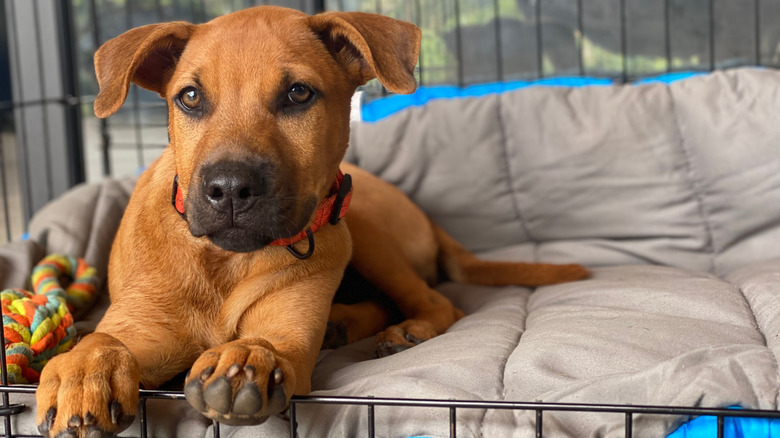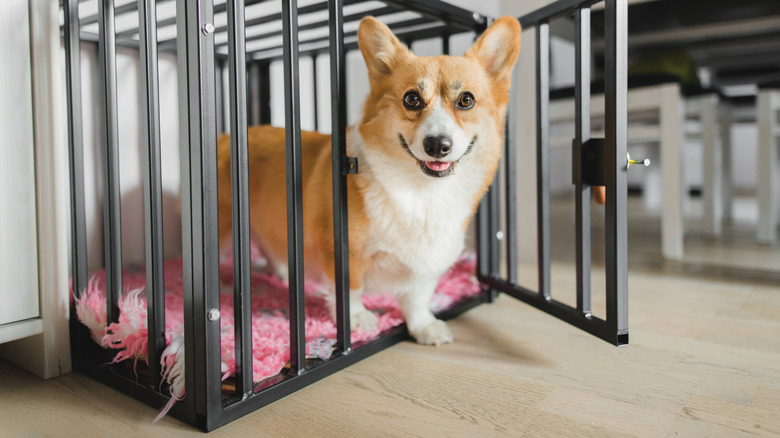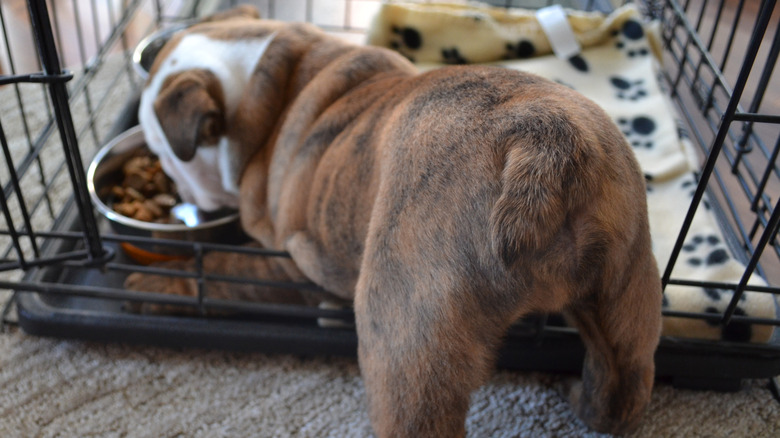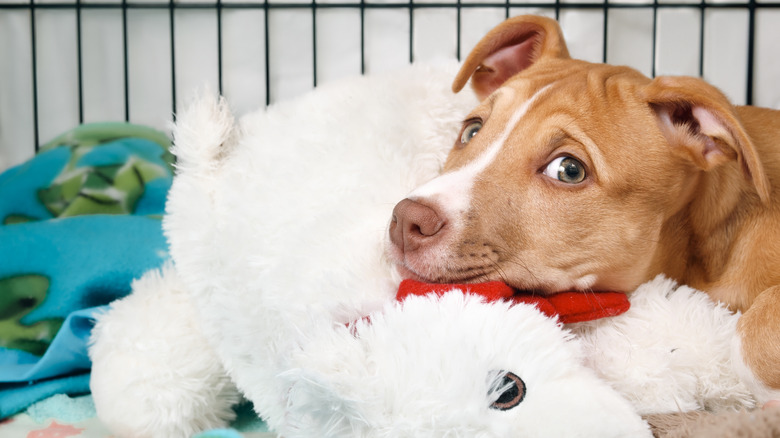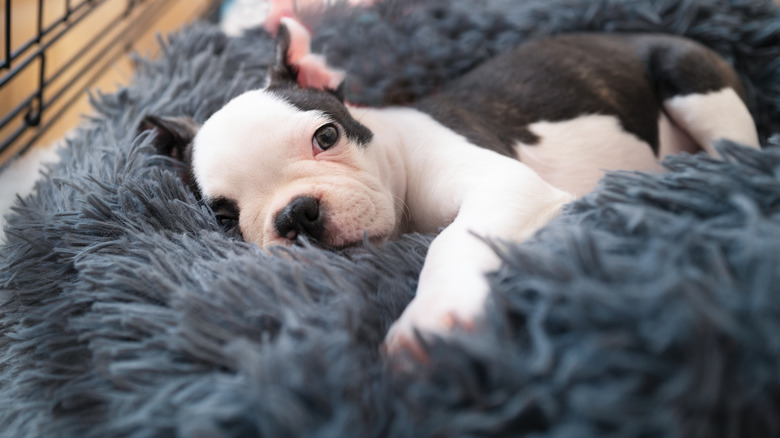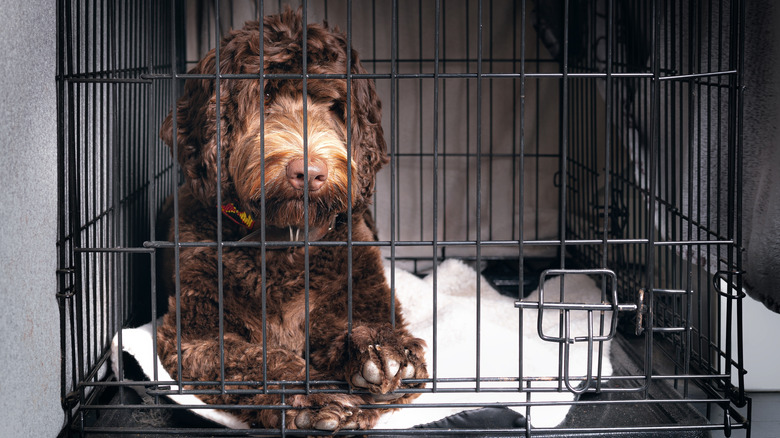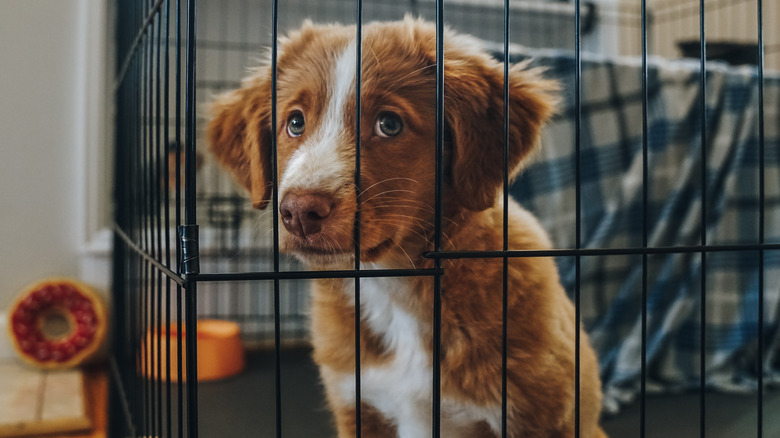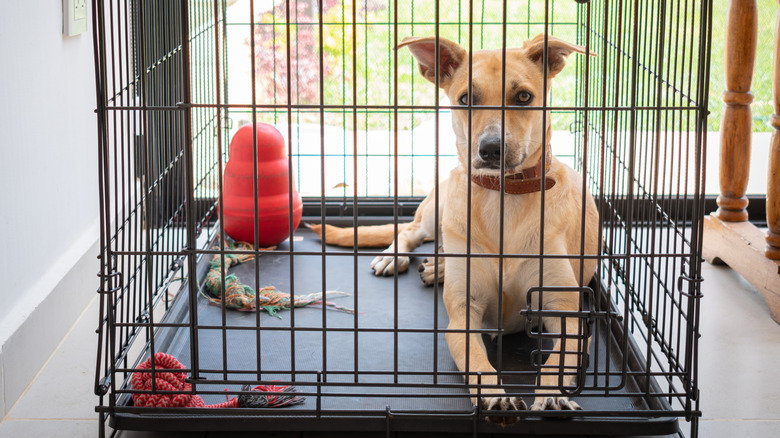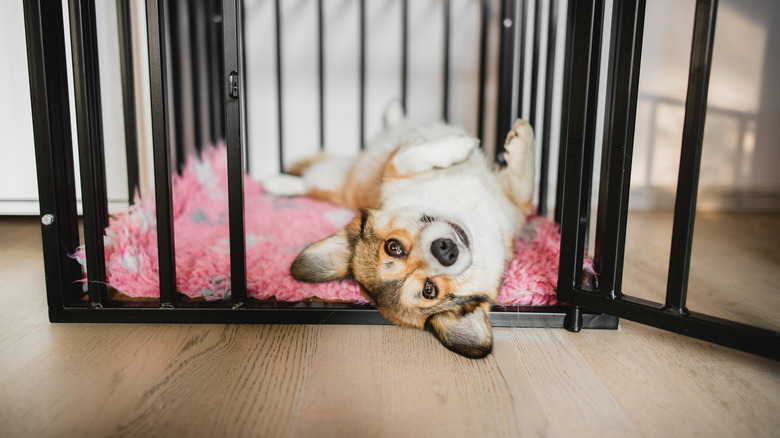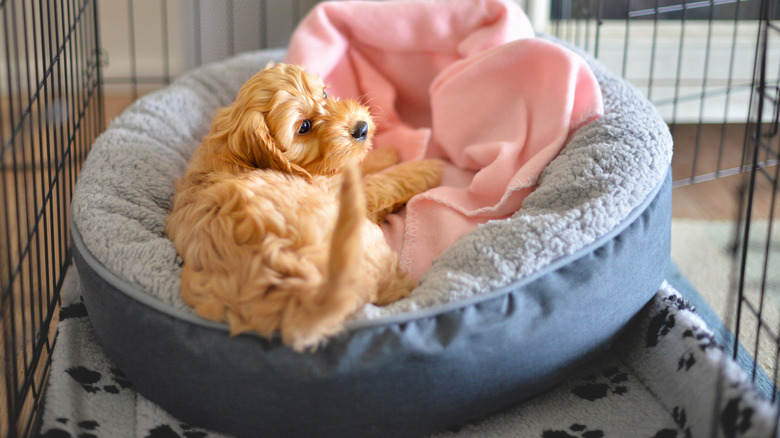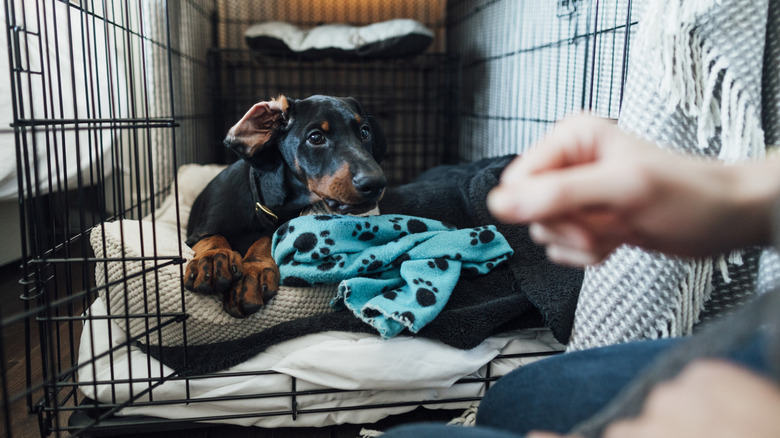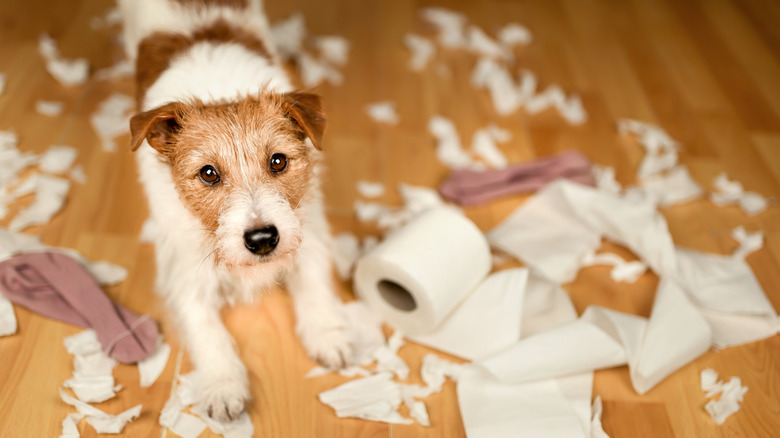11 Tips To Make Crate Training Your Puppy Easier
If you're worried about your puppy getting overstimulated when you have visitors, chewing things up when not directly supervised, soiling the house while you're gone, or being able to travel comfortably, crate training can be a powerful solution. Sometimes dog owners project their own feelings about being confined in a small space onto their pets, thinking that because they wouldn't want to spend time in a crate, their canine won't want to either. However, dogs have a denning instinct that humans don't, which means they appreciate having a small, cozy space to call their own.
When properly introduced and applied, a crate doesn't seem like a prison to your pup. Instead, it's their home and safe space. With successful training, your puppy's crate becomes a protected enclosure for them when they need it, peace of mind for you when you're away for short periods of time, and a safe container they can travel in for relocation or an emergency. "If the dog's freaking out, they think, 'I can go hide in my crate and it's safe here and nobody's gonna bother me.' That helps them out for their lifetime," Christine Kroh, intake coordinator at Beagles to the Rescue, explained to the American Kennel Club.
The path from a "chews everything" or "nervous when visitors arrive" puppy to a "calm and crate-trained" dog may not be immediately obvious — especially if you approach it while thinking like a human. The key to success is putting yourself in your puppy's shoes, figuratively speaking, and helping them forge a positive relationship with their crate. Once you've started, it's important to stay consistent, because the process may take up to six months — although some puppies catch on much more quickly.
Choose the right crate for your future adult dog
Ideally, your puppy's crate should be a lifelong investment — which means it must be large enough to fit not just your pup as it is now, but its eventual adult size. If you're not sure what that is, there are a few ways of estimating how big your puppy will grow. Your options include investigating the size of your dog's parents or checking breed standards if your puppy happens to be purebred. When in doubt, chat with your vet. They can help you arrive at a reasonable prediction of how large your puppy will get.
However, bigger isn't always better. The crate should be large enough for your puppy to stand up and lie down in, even when full-grown, and to turn around in comfortably. If it's too large, your still-small pup might feel like it has enough room to soil one side of the crate and sleep on the other — not the sort of habit you're looking to build. The solution is to use a divider inside of the crate, creating a temporary, smaller space that your puppy's denning instinct will encourage it to keep clean and tidy. As your dog gets bigger, you can adjust the divider, giving it increasingly more space.
Your choice of crate design and material matters, too: To start, it should be sturdy enough to resist chewing. If your dog prefers feeling enclosed in a dark, quiet space, you might want to use an airline-style kennel at home, even if you're not traveling, because it feels more private. Or, you could cover a more open, wire-style dog crate with a blanket to help create a calm, quiet ambiance. However, this approach comes with some caveats. "The most important thing to remember is that a cover can cause a crate to heat up and should only be done if someone is home to supervise, since it's important to make sure the pet gets proper ventilation," Kelly Armour, a certified trainer and behavior analysis specialist advised PetMD.
Train your puppy to go in the crate on its own
There's a natural progression when it comes to crate training: First you have to get your puppy to go into the crate of its own accord, usually by tossing a handful of kibble innside and giving it the verbal command to enter — perhaps "crate" or "go home." Your puppy follows the kibble — who doesn't want second breakfast? — and your initial mission is accomplished in that moment.
To ensure that behavior becomes repeatable on command, consistency is key. Repeat the kibble toss with the verbal command and, over time, your pup will learn to go into its crate with just the command and perhaps a "throwing" wave of your hand, no more food required.
Another trick is to keep the crate open and placed somewhere that you and your family spend time anyway, so that if your pup enters it spontaneously, you'll be around to praise it. Hiding treat puzzles in the crate, or favorite toys, is another way to stimulate your puppy's natural urge to explore, which you can then reward any time it goes into the crate to investigate.
Keep the crate close by and look out for potty cues
Ideally, your puppy's crate should have a set place in the home that's convenient for both of you. But when you first start crate training, position it somewhere close to you. For example, if you're training your puppy to sleep in its crate at night, consider keeping it near the bed at first — even if that's not where you want it to ultimately end up.
This is the best course for two reasons: First, your nearness may comfort your puppy and help it feel more comfortable sleeping in the crate. Second, keeping it close means you can listen for whining and other cues that signal it needs to go outside to defecate or urinate, which puppies under 6 months of age may need to do every three or four hours. Puppies generally need to go outside more often than grown dogs, and whining is one of their only means of letting you know about the impending consequences if it doesn't happen.
Once you and your puppy have established a comfortable routine and it doesn't need to be let out in the middle of the night, you can gradually move the crate to its permanent location. How quickly you can move the crate depends on your dog; the goal is to make adjustments without disrupting the routine and level of comfort you've created.
Create positive associations
Feeding your puppy in its new crate doesn't just induce it to go in there and stay a while: It also helps create a lasting, positive impression of the space. This is key for making it actually want to go inside, and feel comfortable while it's in there.
If your puppy hasn't yet started forming a positive bond with its crate, there are several things you can do to help foster those associations. They include adding blankets and dog beds to make the crate more physically comfortable, a favorite toy, and something that smells like you (as long as your dog won't chew it up). You can also adjust the location of the crate if it's near anything that's too loud, hot, cold, or unpleasantly smelly to your dog's nose.
Above all, don't use time in the crate as a punishment. It's better to think of it as a proactive behavior-management tool than as a temporary holding cell for puppy miscreants. Instead of waiting for your pup to jump all over visitors and then putting it in the crate as a punishment, place it in the crate before your visitors arrive. The inclusion of an interactive treat or toy can keep it entertained and continue building that positive association with the crate as its safe, happy place.
Start with supervised stays in the crate and work up to short periods alone
Starting with small, manageable stays in the crate will help build a pattern of success. Instead of just tossing a handful of kibble inside, go ahead and feed your puppy a full meal within. Close the door while it eats, then open it again after it's finished. Once that feels comfortable and easy, your next step is to keep the door closed for a minute after your pup is done eating — then gradually increase that time. The key is progression. Keeping your puppy's initial crate stays short, then increasing them in small increments, helps you build success upon success, fostering mutual confidence, comfort, and trust.
It may be tempting to think that once your puppy can stay inside the crate for a while with you nearby, you can just walk away and leave it there. The truth is, for some dogs that'll work fine — but for others it'll be too much, too fast, and might even set back your training. You should tackle alone time in the crate gradually, too.
After you close the door on the crate, spend a couple minutes sitting quietly nearby before you leave the room for another minute or two. When you come back, spend another couple of minutes sitting quietly by the crate before you open it. This helps keep your dog calm as you come and go by ensuring the crate door opening and closing isn't directly tied to your arrivals and departures. Once you see that your puppy is comfortable being alone inside the crate for short periods of time, you can gradually increase those periods and work up to leaving the house entirely.
Ignore your puppy when necessary
To get your puppy to stop barking, whining, or otherwise vocalizing when in the crate, you'll need to discern why it's doing so. Does it need to go outside, it feeling bored, or is there another reason entirely? Unless it is in physical discomfort or requires a bathroom break, the best solution is often to leave your pup where it is until it quiets down. As soon as it's calm and silent, that is your opportunity to let it out of the crate. Otherwise, you risk teaching it that vocalizations are what causes you to open the door.
It may feel harsh or cruel to leave a "crying" puppy in its crate. After all, you're its entire world, and you want it to be happy. But a little effort and perseverance now will pay off in spades later, as the habits you form in the present will persist for the rest of your dog's life. If it learns that whining or barking will get it out of the crate, it'll be much harder to change that perception in the future.
Use a camera to keep tabs on your puppy while out of the house
Once your puppy can stay in it crate for up to half an hour when you're in the other room, it's time to leave the house. It's important to retain your habit of sitting quietly next to the crate for a few minutes before leaving, and sitting quietly by the crate for a few minutes after returning, so the puppy doesn't link the door opening and closing directly to your arrivals and departures. But you should also vary when you put your dog into the crate during your departure routine to avoid creating other inadvertent "I'm going to leave you alone now" cues that might nudge your young dog into separation anxiety.
If you're feeling anxious yourself about leaving your puppy alone in its crate, or just want to monitor its behavior in your absence, a nanny cam or video baby monitor are both great solutions to let you observe it remotely. If you're really motivated, you can even use the nanny cam to time your arrival for a moment when your pup is quiet and calm — the optimal time to let it out of its crate.
Create a calm environment
This tip applies to both you and your puppy: In a perfect world you should be as calm and relaxed as possible while putting a puppy in its crate, whether you're doing that with a verbal command or physically. At the same time, try to avoid putting it in the crate when it's in "go" mode; aim for a moment when it's calm instead, or tire it out with a play session and then send it to the crate once it's more relaxed. All of this helps set the tone of your puppy's crate being its safe haven, which helps encourage it to go in and out of it naturally and be content when it stays in there for some time.
Speaking of time, it's important to note that your puppy shouldn't ever stay in the crate all day and night. Although the crate is its safe space, it's not its only place, and it still needs plenty of time and space to explore, play, and interact with the rest of the family.
Keep your expectations realistic
We all want instant results and success, and some puppies do catch on very quickly. But realistically speaking, no crate training will be complete overnight, and for some dogs it can take up to six months of consistent effort on your part. If you're being consistent and still not seeing the results you want, it might be time to consult a professional trainer — but before you do that, consider any other humans in your household.
If, for example, somebody else is letting your puppy out of the crate every time it whines, that can really undermine your progress and prolong, or even thwart, the entire training effort. If you're able to get all the humans on the same page, though, you may be amazed by how quickly your puppy learns.
Train humans to respect the crate
All the people in your household should learn to respect the crate as your puppy's place for quiet time or personal space. If you leave the crate open and available for your pup at all times, you might even notice it "putting itself away" when it needs a respite. Teach children and adults alike to not bother your puppy while it's in its crate, and it'll be more likely to keep using it as the safe haven it should be.
This applies to visitors, too. They might mean well when they chase your ultra-cute puppy around for a hug, or get it so riled up that it jumps up on them in excitement, but they also won't be around to deal with the consequences when it learns that visitors at the door mean it's time for overstimulation, or when it keeps up that "cute" jumping on people after it's grown into an adult-size body. It's up to you to set boundaries with visitors that will help your puppy feel safe, ensure its crate remains a haven for it, and ultimately guarantee you a much easier life in the future with your canine best friend.
Stay alert for separation anxiety
Crate training may help prevent separation anxiety from developing, or it help control the damage caused by an already-anxious pup in your absence. However, it's not a remedy for separation anxiety that's already in place; you may need special counterconditioning and products to ease your dog's separation anxiety.
How can you tell if your puppy is experiencing separation anxiety? "If your dog is exhibiting symptoms such as howling, drooling, crate soiling, trembling, or self-injury in their crates, they may have separation anxiety and could benefit from working with a trainer who is certified in this specific behavior," Amanda Dwyer, CTC, SAPT, FFCP-T, shared with Rover. You might notice these issues happening on a nanny cam, hear about them from other family members, or even learn of them from your neighbors — or you might encounter the destruction firsthand when you come home.
Some of these behaviors can be caused by health issues, so it's a good idea to see your vet and rule out medical causes. If none are apparent, there are some steps you can take to manage your dog's separation anxiety, or you might need to consult an animal behaviorist.
